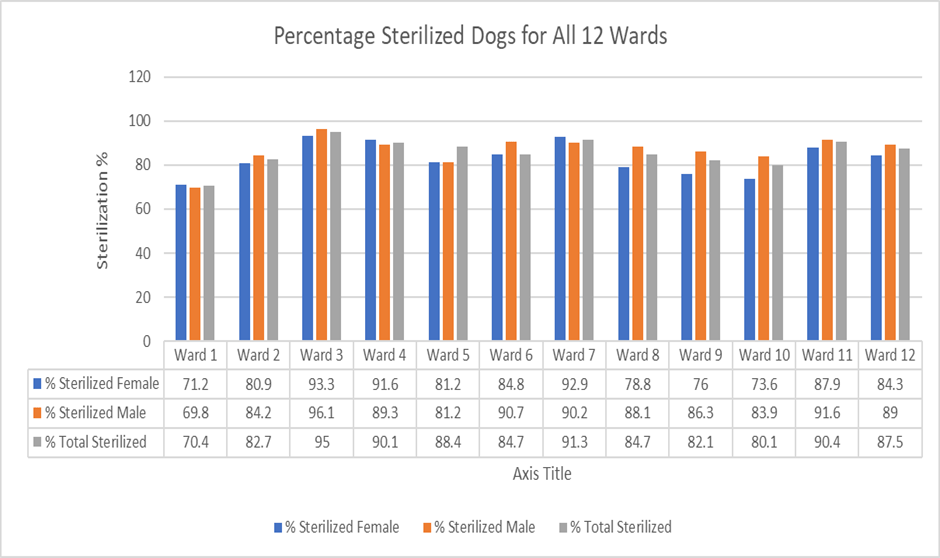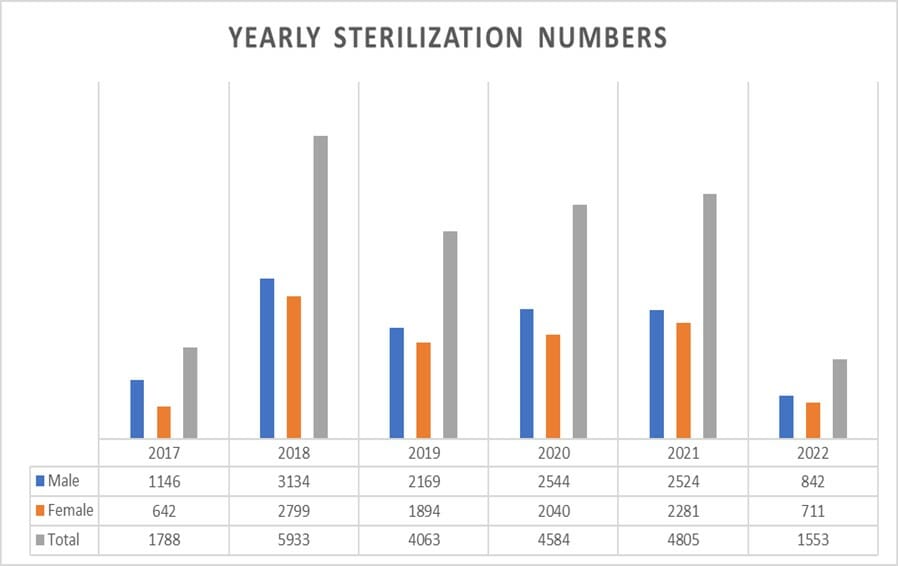It’s 6:30 am on a quiet street in Nutan Society, Vadodara and a vehicle comes by. Three people wearing green T-shirts alight and start moving about, calling out to the street dogs, petting and then catching them by hand. A woman moves towards them, shouting at them, unsure of their intent. Calmly, one of the members stops to explain about the animal birth control programme, assuring her they will sterilise, vaccinate the dogs and drop them back in a few days. They provide her the facility’s details and invite her to see the work first hand. She visits the place and is happy to see how things function. Even more so, when the dogs are dropped back – now vaccinated and sterilised.
There are many organisations in India working on Animal Birth Control (ABC), the only legal and humane way of managing the vast populations of street dogs in the country. Major cities like Jaipur, Mumbai, Chennai, Ahmedabad and Bangalore have had long-running ABC programmes, some more successful than others.
Read more: Animal Birth Control for street dog management: It’s time for an upgrade
One such city is Vadodara, the second largest city in the state of Gujarat, which in just five years has achieved and surpassed an 80% sterilisation rate among its entire street dog population.
Humane Society International/India launched an ABC programme in the city in 2017 in collaboration with the Vadodara Municipal Corporation (VMC). The primary motivation was to improve the welfare of street dogs by reducing the population through sterilisation and vaccination. With support from VMC, a total of 23,696 dogs have been sterilised to date, bringing the total percentage of dogs sterilised to 86%, from a starting estimate of 36%.
Achieving this high sterilisation rate was not without challenges especially in a large city like Vadodara: Working in a less than ideal facility, navigating complex relationships with the municipal corporation and with other animal welfare organisations, managing community complaints pertaining to dogs, handling community conflicts, and securing community buy-in. In Vadodara, HSI/India has implemented what is termed a Dog Management Programme – a new integrated ABC model which incorporates intensive Community Engagement. The result has been a paradigm shift in the city, not only in street dog sterilisation and vaccination rates, but in the relationship between communities and their street dogs.
Establishing Infrastructure: Cattle Shed Turned Operation Theatre
For conducting any dog sterilisation programmes, securing adequate land and a suitable building is a must. For the Vadodara Dog Management programme, the VMC had initially offered a disused cattle shed. Unfortunately, that came with a full set of challenges, including limited space. It was simply not set up to house dogs. However, with some creativity and determination, in four months the site was converted into a fully functional facility to conduct surgeries, equipped with an operation theatre, a kennel area for post-operative dog care, dedicated space for anaesthesia and patient preparation, and a dog holding area.
KAP Surveys conducted for the first time in the city
In order to plan an effective dog population management programme, baseline data is necessary. HSI/India conducts dog population census surveys to get a baseline for any city to accurately assess just how many dogs there are in a given area. Then, once a programme starts, the team conducts monitoring surveys twice a year to track progress and impact.
In November 2017, along with a street dog population count survey, a Knowledge Attitude and Practice (KAP) survey was conducted for the first time. This survey focused on better understanding the city’s pet dog population as well as community perceptions about street dogs.
The findings indicated that:
- 49% of residents saw 4-6 street dogs in their neighbourhoods
- 42% were not concerned about the number of street dogs, while an almost equivalent number were very concerned
- 35% thought the number of dogs on their streets had increased over the years
- A nearly similar number of people wanted to either remove, adopt, shelter/sterilise and vaccinate street dogs OR leave them alone/ eradicate them
- Only 25% were aware of any ABC project being implemented in their city
While this survey was being conducted, HSI/India was already considering how to integrate community engagement with the traditional surgical approach taken by ABC programmes, to peacefully resolve human-dog conflict and address people’s ongoing concerns.
Complaint management and community engagement
After overcoming the infrastructure hurdle, the programme quickly started sterilising and vaccinating dogs. The next priority was community engagement. Managing the helpline, often flooded with complaints and inquiries, while carrying out the dog capture and sterilisation activity made for a rather busy day for the team members.
The community engagement programme launched by HSI received 2331 complaints and responded to and resolved 100% of them. Some 12% of the calls were either duplicate complaints or didn’t provide location and other details about a case. The resolution included either only listening to people’s grievances or physically being present at a site and picking up dogs or referring complaints for treatments to the local organisations.
Typical complaints were about dogs barking, biting, chasing, defecating or urinating in common pathways, requests for relocation, sterilisation, vaccination and conflicts due to improperly planned feeding and watering spots.
While attending to these complaints, the team recognised the need to make increased community awareness efforts, regarding rabies, recognising and identifying unsterilised dogs, the law concerning relocation of dogs and general dog behaviour.
The success of any dog management programme is largely dependent on community perception and attitudes towards street animals. To address awareness gaps and create more positive perspectives towards dogs, HSI/India launched the ‘Abhay Sankalp’ campaign. Our approach included informal gathering of residents, volunteers, and societies to discuss street dog issues, and scenarios in which team members visited residents to address major concerns.
Read more: Bengaluru’s Canine Squads ensure well-being of street dogs and the local community
Over time, as awareness increased, the number of complaints about street dogs gradually diminished and requests for sterilisation and vaccination increased. Between 2021 and 2022, Vadodara saw a 160% reduction in complaint calls.
From people wanting to get rid of dogs to now wanting to sterilise and vaccinate them, there was a dramatic change in approach and a stark difference in the perception and mindsets. The COVID-19 outbreak and the lockdown saw a shift to online efforts. We conducted webinars for approximately 5,000 community caretakers and other stakeholders on canine nutrition and caring for dogs during summer months, rabies and conflict management.

As a result of this widespread community engagement, a total of 314 animal societies in Vadodara in 2022, have 100% of their dogs sterilised; 217 societies have collared their community dogs; and 315 societies have established designated feeding and watering spots.
Sterilising beyond 70%: Innovation Is The Key
By 2019, Vadodara had achieved 72.8% dog sterilisation. This is not only on paper, but visible on the streets with the increasing number of ear-notched dogs one sees.
According to HSI/India’s agreement with VMC, the goal was to achieve 70% dog sterilisation and vaccination in the city. And we had done so. Were we to close and move out, transitioning potentially to a new city? Covid’s lockdown led to a stop in work and a drop in the sterilisation rate to 69%.
It was becoming a more resource-intensive process to locate unsterilised dogs. Innovation was needed.

We developed the protocol for pre-checking – a meticulous and time-intensive process of a two-member team going out on a bike at early hours of the morning, identifying unsterilised dogs and tagging them on the phone app street-by-street. This information was then shared with the catching teams who were able to plan their routes for the following days accordingly. This strategy helped push through the next phase and achieve the elusive 80% and eventually the 86.4% sterilisation rate that we now have in Vadodara.
Building trust
Our sterilisation and vaccination work, reinforced by community engagement, has been successful because of the trust built with all the stakeholders. Dogs picked up for sterilisation are always returned and anyone is allowed to visit the programme to see how things are done. Members of the public are also encouraged to bring their street dogs to the facility directly, if they have any concerns with animals being picked up by the team.
The future for Vadodara’s street dogs
For any programme to be sustainable, the ownership should be local. Vadodara has strong local capacity thanks to a progressive Municipal Corporation. It is also home to more than 200 volunteers and community caretakers who’ve been a part of the Abhay Sankalp initiative. Now they constitute the first line of care for street dogs in the city.
The more cities in which we successfully build humane and sustainable programmes, the easier it will become to make the case for street dogs in other communities facing some of the same challenges. Step by step, city by city, region by region, we can get there.

Really, this is a wonderful case study for all states to follow. Great Going Vadodara.